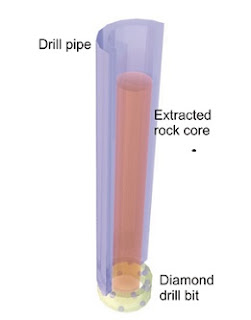It is said (with good reason) that a little bit of knowledge is a dangerous thing; an adage to which we at the Antisocial Network are inclined to say, "No duh." Perhaps the only thing worse than a little bit of knowledge is no knowledge at all. A disturbing number of people who wrote for content farms, sadly, fell under the second category; yet they were more than happy to share their ignorance with the world for a few bucks. Let us take a look at one such self-appointed wordsmith, returning DotD Felicia Dye. This time out, we'll see what dumbassery Dye managed to pack into the WiseGEEK post "What is Diamond Drilling?" which lives in the niche site AboutMechanics.com.
Truth be told, that's an open-ended question: diamond-tipped bits are routinely used in all manner of industries, from dentistry to mining; wherever the substance to be drilled is relatively hard. You can even buy diamond-tipped drill bits of your own to make holes in ceramics or glass. Felicia, for what little it's worth, decided that the only form of "diamond drilling" must be that employed in core drilling by the petroleum industry. To make matters worse, Dye decided she needed to explain the whole drilling process. Woe be upon anyone unlucky enough to read her crapola!
Oh, Felicia started out okay-ish, prattling about industrial diamonds:
"...[industrial diamonds] can be used to make the drill bits used for diamond drilling. These bits are often designed to penetrate a particular type of material and may not be suitable for other types of drilling."
You know she was in over her head when she couldn't even elaborate on that "particular type of material"! No, according to Felicia, diamonds "can... be used to make tools that are required for hard jobs." Nowhere else in her text does the word "hard" appear! How difficult would it have been to mention the "particular materials" that require diamond drills, and why? Duh.
When it came to describing the drilling process (why, we aren't certain), Felicia was again clueless. After rattling off a half-assed definition of the rotary drilling rigs used in geological exploration, ending with the nonsensical claim that,
"...the diamond bit... is a circular tool that has an open middle area and clears entry into the ground."
We're still trying to parse that "clears entry into the ground" bit, but it's quite clear that Felicia reduced the universe of diamond drilling to one process: coring a well – and she did a lousy job of that! Take for instance:
- The assertion that "The drill uses rotary action to provide power to force the drill bit into the ground." Idjit, gravity "forces" the drill string into the ground.
- The claim that, "...the drill bit penetrates the Earth and the drill rod slides in"; a bizarre reinterpretation of a drill string – an end-to-end stack of long, hollow pipes screwed together – as a "rod"...
- And here's Felicia's understanding of the drill string itself: "When one drill rod is completely in the ground, another is usually screwed to the top of it allowing deeper penetration. Once all the necessary drill rods have been filled with cores, they are retrieved from the ground." Apparently, Dye thought that exploration wells are cored from top to bottom. Again, what an idjit!
- And how about the information garnered from cores? "This includes mineralization, recovery percentage, and rock quality." Duh.
Dye reduced the field of diamond drilling, which ranges from dentistry to gemology to concrete coring to mineral and hydrocarbon exploration to one example, which she defined and described from a position of ignorance. Hell, she never even mentioned the use of drilling fluid to cool and lubricate the bit, and remove cuttings. Duh.
All that's par for the course for our Dumbass of the Day, a freelancer we're calling out for the fifth time. Go, Felicia...
DD - MECHANICS

No comments:
Post a Comment